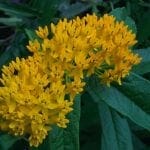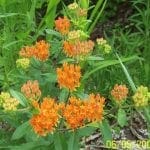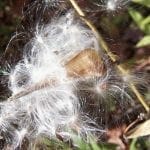2010 Plant Of The Year | Asclepias tuberosa
Voted the GNPS 2010 Plant of the Year, butterfly weed is a common, long-lived and striking perennial native to North America from southern Canada and New York to Minnesota, south to Florida and Colorado. This flowering perennial is often found along roadsides and naturalized areas, dry open fields, and grassy places, making the butterfly weed a great subject for ‘ditch botany.’
The bright orange, yellow, and red flowers of Asclepias tuberosa are, as the name suggests, a butterfly magnet. Other common names are butterfly milkweed, butterfly plant, orangeroot, or orange milkweed.
Butterfly weed is a type of milkweed (Asclepiadaceae or Apocynaceae): this family includes plants with milky sap which is poisonous to most insects. Unlike the other milkweeds Asclepias tuberosa contains little or no milky juice. The leaves are two to six inches long, grow closely all the way up the stem and are hairy, unserrated, lanceolate, alternate, sessile and dark green on top, lighter beneath. Stems are branched near the top and have flat clusters (umbels) of many very showy quarter-inch flowers in shades varying from pale to deep yellow through vibrant orange to bright red. These flowers usually bloom from June to September, often extending through late fall here in the Piedmont. Appearing in the autumn, the fruit of the butterfly weed is quite distinctive. The seed pod is 4 to 5 inches long, oval-shaped and contains numerous small seeds each with a tuft of long silky hairs or floss, making them easily airborne. The root is spindle-shaped, large, branching, white, and fleshy with a knotted crown. It sends up several erect, stout, round and hairy stems, growing from 2 to 4 feet high. This plant is often slow to emerge in spring, preferring to wait for warmer temperatures.
Since it is a prairie plant, butterfly weed is an excellent selection for meadow and other naturalized plantings because it prefers full sun and well-drained soil. Asclepias tuberosa will perform well in dry conditions, but will also tolerate a wet environment. Due to its long bloom time and other attributes, this ‘weed’ is a wonderful, low maintenance perennial for the sun garden.
Butterfly weed is easy to grow and easily propagated from seed or cuttings. It is a little more difficult to transplant as this plant has a deep taproot. Although non-invasive, butterfly weed can spread energetically given the right conditions.
Being a milkweed, butterfly weed is a potential host larval plant for the caterpillars of the monarch butterfly (Danaus plexippus), although the common milkweed is perhaps a better choice. It is also a favorite nectar-source for a number of butterfly species, including the tiger swallowtail and black swallowtail. As a bonus for your garden, butterfly weed is deer-resistant.
Butterfly weed is both edible and medicinal. The plant, including its stems, leaves, flowers and seed pods, was used mainly for food and clothing. The seed pods are edible when cooked young before the seed floss forms. Cooked flowers are reported to taste like sweet peas. Leaves and new buds are edible and when cooked taste like spinach. The stems have been used to make a quality fiber and woven into twine or cloth. Interesting historical uses of the seed floss was for stuffing in pillows and life jackets, and candle wicks. Research indicates the floss is effective at cleaning up oil spills at sea.
Asclepias tuberosa has a long history of use as an alternative medicine in America. The root harvested in fall and then dried is medicinal with a number of characteristics: antispasmodic, carminative, mildly cathartic. It is a diaphoretic, diuretic, expectorant, tonic as well as a vasodilator. Butterfly weed has been used internally for the treatment of diarrhea, dysentery, chronic rheumatism, and as an expectorant. Due to effect on the lungs, butterfly weed is also valuable as a remedy for many chest complaints and lung diseases. In fact, one of its traditional common names is pleurisy root. A medicinal poultice of the roots has been used in the treatment of swellings, bruises, wounds, and skin ulcers.
Prepared by Jacqueline McRae & Paula Reith, co-chairs Plant of the Year Committee, for the Georgia Native Plant Society.



